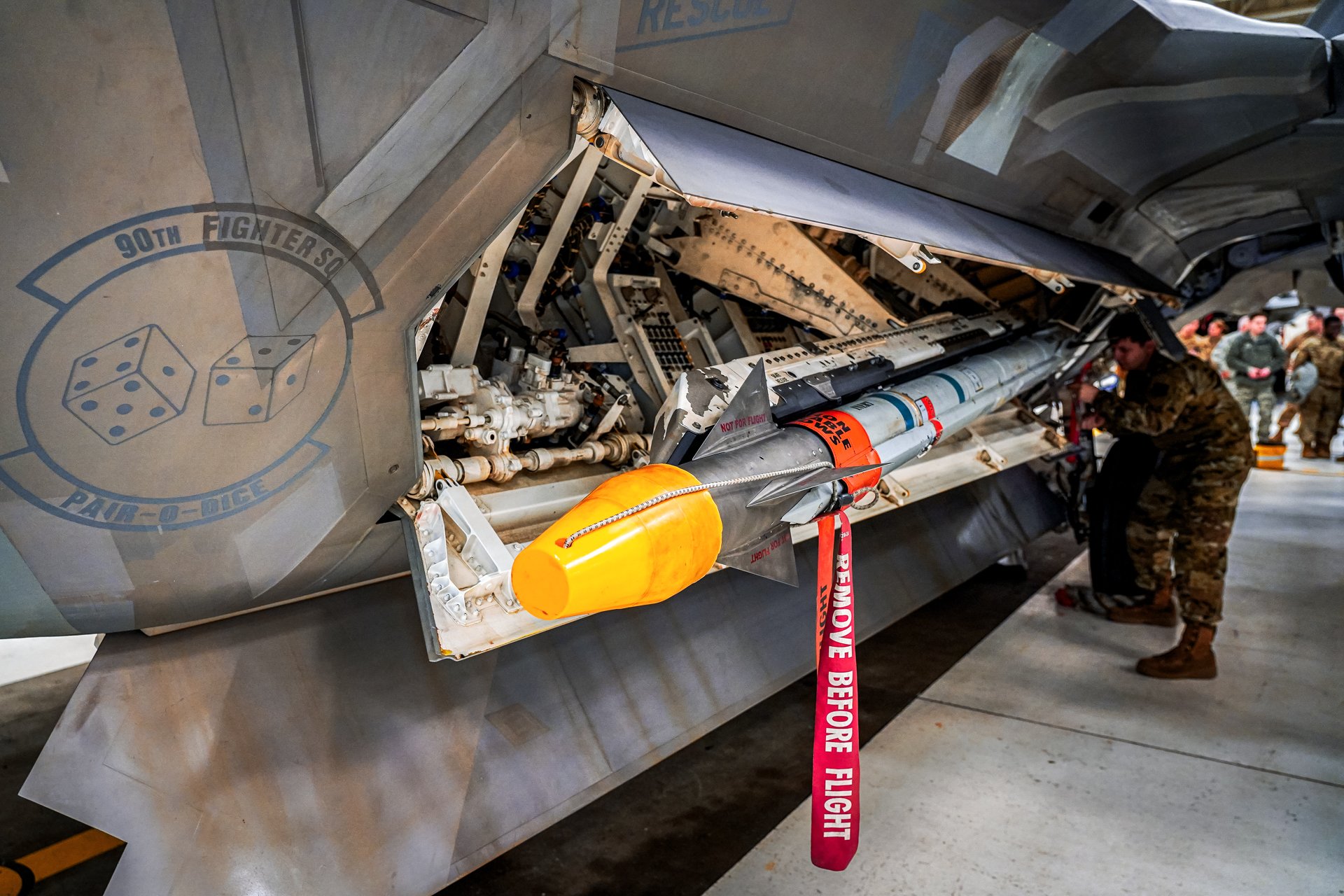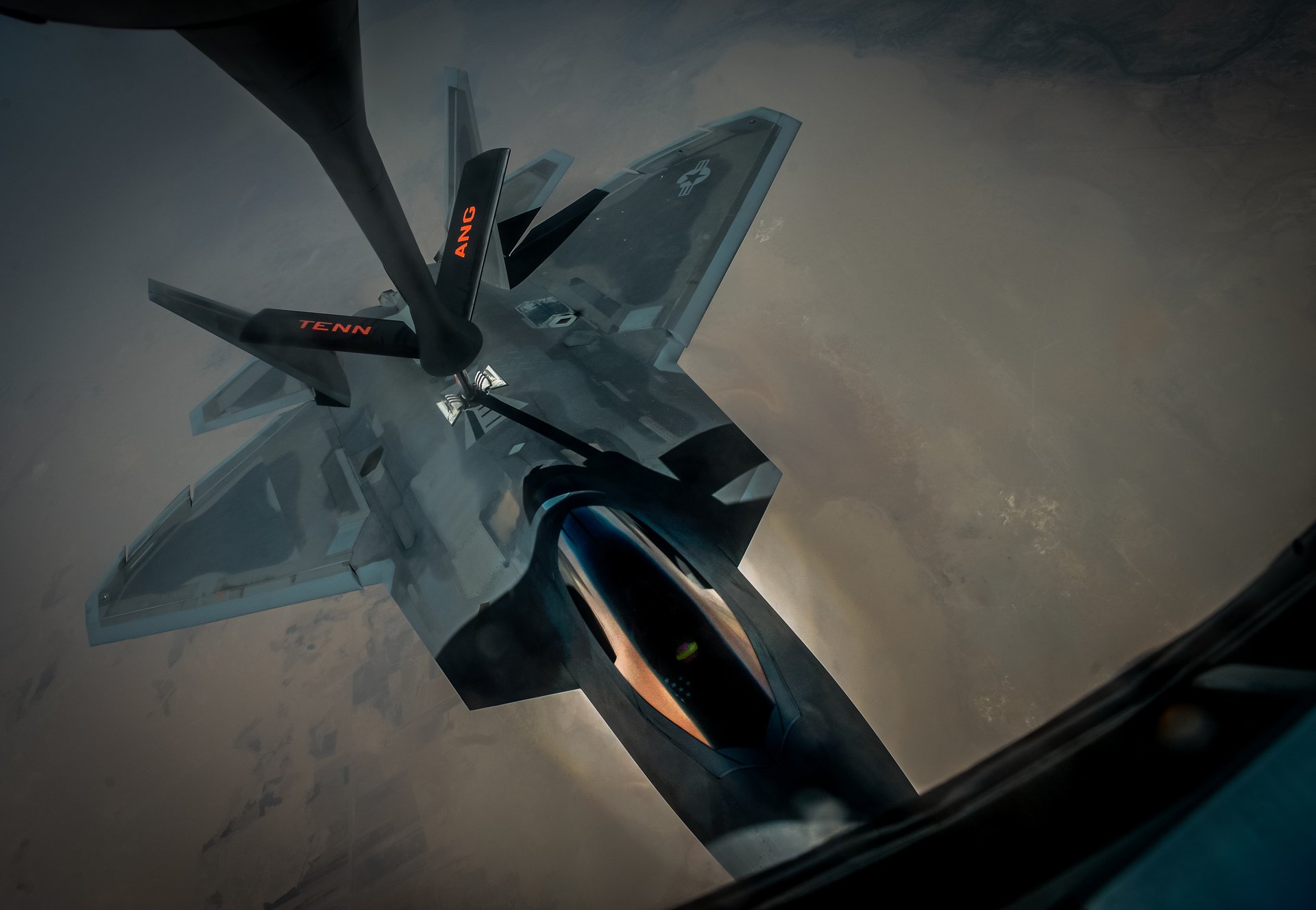The F-22: The Superiority Fighter That Never Shot Down an Enemy Plane

Air Combat Command’s Gen. Mark Kelly posted this conceptual image on Instagram of an F-22 firing the AIM-260 Joint Advanced Tactical Missile in 2022, offering the first official glimpse of the new weapon. US Air Force illustration.
The F-22 Raptor made its maiden flight in 1997, eight years before it entered service. The fifth-generation fighter featured twin Pratt & Whitney engines that could be repaired using six tools from any hardware store, an internal weapons bay to reduce drag, and the perceptibility of a bumblebee when tracked on radar.
Twenty-five years later, US Air Force Chief of Staff Gen. Charles Q. Brown Jr. announced that the branch intended to downsize its fleet of fighter jets to a smaller “mix” of airframes. Despite all its impressive qualities, the F-22 didn’t make the cut. Which means that, if the Air Force has its way, the Raptor could soon be retired from service with just two air dominance kills to its name.
There are two reasons the Air Force wants to phase out the Raptor and they are kind of interrelated. The first is the enormous costs associated with flying the plane and maintaining the fleet to keep it combat-ready. The second reason is that much of the F-22’s technology is already obsolete by advanced tactical fighter standards.

US Air Force Maj. Paul "Loco" Lopez, F-22 Raptor Demonstration Team commander/pilot, flies a practice demonstration at Langley Air Force Base, Virginia, Aug. 1, 2018. US Air Force photo by Senior Airman Parker Dubois.
Yet the Raptor remains one of the most advanced air platforms on the planet. Everyone, from generals to journalists, and every politician in-between, loves to compare the F-22 to the best fighters flown by Russia or China. The problem is that the jet was too far ahead of its time. The Iron Curtain fell before the F–22 entered service, meaning that the Soviet MiG and Sukhoi fighters it was designed to fight were no longer a significant enough threat to justify its existence. And now that the prospect of large-scale conventional warfare is back on the table, the F-22’s integrated avionics are too old to be compatible with the Air Force’s modern networked communication and data-sharing systems.
F-22 Speed and Capabilities
By the early 1980s, the Soviet Union had already developed two fighter aircraft to counter the US Air Force’s F-15 Eagle and F-16 Fighting Falcon. That left the US Air Force in need of a warfare system that could not only counter the Soviets' Su-27 "Flanker" and MiG-29 "Fulcrum," but could also contend with the next generation of enemy fighters.
What the Air Force ultimately came up with was a cutting-edge air platform that was unlike anything the world had ever seen. Highly lethal and sophisticated, the F-22 was just what one might expect from a joint venture between defense industry giants Boeing and Lockheed Martin. It had a “supercruising” speed of 1.8 mach without afterburners, a maximum speed of mach 2, a combat radius of 600 nautical miles, and an endurance of eight hours.
Furthermore, the F-22 was insanely stealthy, thanks in part to it housing its diverse arsenal of weapons in three internal bays. Since externally mounted weapons contribute to radar reflection, internal bays mean the F-22 sacrifices none of its stealth to carry a heavy payload. And its advanced electronic warfare system and integrated avionics allowed pilots to precisely aim its air-to-air missiles, air-to-ground missiles, and bombs.
Perhaps the most incredible feature of the F-22 is a thrust-vectoring system that makes it extremely agile in a dogfight. Nozzles on its twin engines can shift the plane’s 70,000 pounds of thrust in a different direction as it moves to perform almost physics-defying maneuvers.
With all that great technology, what the F-22 didn’t have was an enemy. By 1997, the Soviet Union had become the Commonwealth of Independent States, and US-Russia relations were actually pretty warm. Meanwhile, China was still six years from the beginning of its “peaceful rise.”

Airmen assigned to the 90th Aircraft Maintenance Unit compete during a timed F-22 Raptor load crew competition on Joint Base Elmendorf-Richardson, Alaska, on Jan. 31, 2020. US Air Force photo by Justin Connaher.
Why the US Stopped Production of the F-22
The United States has long been the undisputed leader in stealth aircraft technology and it was determined to maintain that status when the F-22 entered service in 2005. For that reason, the Raptor was not designed to be sold or loaned to foreign countries, not even US allies. At one point, the Department of Defense requested an exportable version, but Congress wouldn’t authorize it.
It is also important to note that the Raptor entered service while the US was fighting two asymmetric wars against an enemy that would never be flying anything that might require the services of a fifth-generation air superiority fighter. Since selling the F-22 wasn’t an option, the DoD didn’t have much foreseeable use for the 750 units it ordered. Thus, in 2009, that order was cut to 186.
Meanwhile, the DoD began shifting its focus to its latest fifth-gen fighter, the F-35, which was developed for multiple roles. Those roles included acting as an intelligence, surveillance, and reconnaissance (ISR) asset and battle manager, as well as conducting air-to-air combat, air-to-ground support, and electronic warfare operations.
Lockheed repurposed much of the same infrastructure used to build the F-22 to produce the F-35, which means that restarting production of the F-22 would be an overly expensive venture for an already aging airframe. Yet, while production of the F-22 has stopped, it is still part of the Air Force’s operational fleet and will remain in service until Congress officially approves its retirement.

A US Air Force F-22 Raptor receives fuel from a KC-135 Stratotanker assigned to the 340th Expeditionary Air Refueling Squadron during a mission in support of Operation Inherent Resolve on July 31, 2017. US Air Force photo by Staff Sgt. Michael Battles.
The Cost of the F-22 Is Piling Up
The Air Force now has 183 F-22s, but only 150 of those were ever ready for combat, and with each passing flight hour, they get more and more expensive to fly and maintain. In fact, now, according to some estimates, one in six Raptors aren’t even capable of flying a combat mission, due to either maintenance issues, lack of spare parts, or just wear and tear.
Deciding to end production of the aircraft also caused the lifetime per unit operational price tag of an F-22 to skyrocket to $143 million almost immediately. That is nearly twice the unit cost of both the F-35 and F-15EX, which are each around $80 million. The cost per flight hour is also twice that of the F-35 and F-15EX. Just keeping the oldest F-22s flying through 2030 will cost around $9 billion.
It’s also important to remember that although the aging F-22 is still considered advanced, it lacks a lot of the latest technologies used by newer jets. Not only would retrofitting the old fighters with new tech be cost prohibitive, doing so could also even negatively affect their performance.

An F-22 Raptor from the 325th Fighter Wing flies alongside an F-35 Lightning II from the 33rd Fighter Wing over the Emerald Coast. The fifth-generation fighter jets flew together in a rare dissimilar formation to salute healthcare workers, first responders, and other essential employees on May 15, 2020. US Air Force photo by 1st Lt. Savanah Bray.
The F-22 Raptor In Combat
Though it’s been in service since the early days of the War on Terror, the Raptor didn’t fly its first combat mission until Sept. 22, 2014. Its target was an Islamic State command and control facility in Syria, specifically the “right side of the building.” The plane’s precise electronic warfare system performed as expected and it demolished the side of the building with a GPS-guided bomb.
Raptors carried out strikes on numerous ground targets in Syria, but their role eventually became more focused on protecting less stealthy fighters. Like a sniper on overwatch, the F-22 relied on its exceptional stealth and advanced sensors to guard friendly aircraft against enemy fighters and surface-to-air missiles.
Perhaps the F-22’s most important contribution to the war against the Islamic State was the threat it represented in the skies over Syria. In 2018, a “combat surge” of F-22s ventured into Syrian airspace and forced Syrian, Iranian, and Russian attack aircraft to withdraw while US troops remained operational, even in areas where enemy air defenses were strongest.
In air-to-air combat, the F-22 has a spotless record — just not against fighter aircraft. In two separate incidents in February 2023, Raptors shot down a Chinese spy balloon off the coast of South Carolina as well as an “unidentified object” over Alaska.

Sailors assigned to Explosive Ordnance Disposal Group 2 on Feb. 5, 2023, recover portions of a high-altitude Chinese surveillance balloon off the coast of Myrtle Beach, South Carolina. A US fighter jet shot down the balloon over US territorial waters on Feb. 4, 2023. US Navy photo by Tyler Thompson.
Is the F-22 Better Than the F-35?
“Better” is a pretty subjective word. The F-22 is considered more advanced than the F-35 in some areas, and obsolete in others. Both airframes are exceptionally stealthy. The low-observable qualities of the F-22, combined with its thrust-vector control, make it the ultimate dogfighter. It also has the lowest radar cross-section of any fighter in the air today.
The F-35, on the other hand, is not as stealthy as the F-22, but its stealth components are more durable. Raptors began shedding their radar-absorbing coating while in the skies over Syria. The F-35’s stealth tech, having been designed with the Raptor’s limitations in mind, is not as vulnerable to harsh atmospheric conditions and can also be more easily repaired.
Another consideration is the 760-nautical-mile combat range of the F-35, compared to the F-22’s 590. In many situations, the Raptor’s lack of range might not rate as a significant limitation, but it could be a major problem when flying missions against great power adversaries like Russia and China. Aerial refueling would leave the F-22 vulnerable to the long-range missiles used by advanced militaries.

The fifth generation F-22 features a unique combination of stealth, speed, agility, and situational awareness, combined with lethal long-range air-to-air and air-to-ground weaponry. Lockheed-Martin photo.
Furthermore, some would argue that the F-22’s superior speed and agility don’t necessarily make it a better dogfighter in the current day and age. The F-35 might be slower and not as maneuverable, but it doesn’t need to be faster or more agile to hold its own against Chinese or Russian fifth-generation fighters or to adequately support ground forces.
The F-35 certainly has its critics, but the truth is that its electronic warfare systems more than make up for whatever disadvantages it might have in close-quarters combat. It can share information with warships and AWACS, the airborne radar systems that provide command and control of the skies, giving all pilots in a squadron a more comprehensive view of their battlespace.
F-35 pilots also benefit from a better personal view from the cockpit, thanks to a distributed aperture system that allows them to literally see through the aircraft.
Of course, both the F-35 and the F-22 were designed for war and will inevitably sustain damage in battle. In a protracted large-scale conflict with a major adversary like China or Russia, it would probably be “better” to have a multi-role aircraft that can be repaired or upgraded and then returned to service relatively quickly — i.e. the F-35 — than a less versatile platform that lacks the support infrastructure necessary to keep it in the fight.
Read Next: SR-71 Blackbird: The Spy Plane That Could Outrun Missiles.

Randall Stevens is a military veteran with more degrees than he knows what to do with. He enjoys writing and traveling, and has an unnatural obsession with Harry Houdini.
BRCC and Bad Moon Print Press team up for an exclusive, limited-edition T-shirt design!
BRCC partners with Team Room Design for an exclusive T-shirt release!
Thirty Seconds Out has partnered with BRCC for an exclusive shirt design invoking the God of Winter.
Lucas O'Hara of Grizzly Forge has teamed up with BRCC for a badass, exclusive Shirt Club T-shirt design featuring his most popular knife and tiomahawk.
Coffee or Die sits down with one of the graphic designers behind Black Rifle Coffee's signature look and vibe.
Biden will award the Medal of Honor to a Vietnam War Army helicopter pilot who risked his life to save a reconnaissance team from almost certain death.
Ever wonder how much Jack Mandaville would f*ck sh*t up if he went back in time? The American Revolution didn't even see him coming.
A nearly 200-year-old West Point time capsule that at first appeared to yield little more than dust contains hidden treasure, the US Military Academy said.












